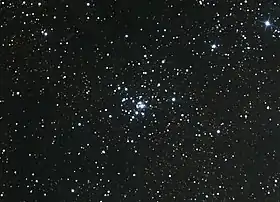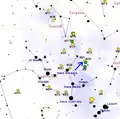Messier 21
Messier 21 or M21, also designated NGC 6531 or Webb's Cross, is an open cluster of stars located to the north-east of Sagittarius in the night sky, close to the Messier objects M20 to M25 (except M24). It was discovered and catalogued by Charles Messier on June 5, 1764.[7] This cluster is relatively young and tightly packed. A few blue giant stars have been identified in the cluster, but Messier 21 is composed mainly of small dim stars.[3] With a magnitude of 6.5, M21 is not visible to the naked eye; however, with the smallest binoculars it can be easily spotted on a dark night. The cluster is positioned near the Trifid nebula (NGC 6514), but is not associated with that nebulosity.[8] It forms part of the Sagittarius OB1 association.[9]
| Messier 21 | |
|---|---|
 Open cluster Messier 21 in Sagittarius Credit: John Saunders | |
| Observation data (J2000.0 epoch) | |
| Right ascension | 18h 04m 13.0s[1] |
| Declination | −22° 29′ 24″[1] |
| Distance | 3,930 ly (1,205 pc)[2] |
| Apparent magnitude (V) | 6.5[3] |
| Apparent dimensions (V) | 14.0′[4] |
| Physical characteristics | |
| Mass | 783.4[5] M☉ |
| Estimated age | 6.6×106 years[5] |
| Other designations | M21, NGC 6531, Cr 363, OCl 26.0[6] |
| Associations | |
This cluster is located 1,205 pc[2] away from Earth with an extinction of 0.87.[10] Messier 21 is around 6.6 million years old with a mass of 783.4 M☉.[5] It has a tidal radius of 11.7 pc,[5] with a nucleus radius of 1.6±0.1 pc and a coronal radius of 3.6±0.2 pc. There are at least 105±11 members within the coronal radius down to visual magnitude 15.5,[11] including many early B-type stars.[8] An estimated 40–60 of the observed low-mass members are expected to be pre-main-sequence stars,[8] with 26 candidates identified based upon hydrogen alpha emission and the presence of lithium in the spectrum.[10] The stars in the cluster do not show a significant spread in ages, suggesting that the star formation was triggered all at once.[11]
As of January 2022, Messier 21 is one of the few remaining objects within the Messier Catalog to not have been photographed by the Hubble Space Telescope.[12]
Gallery
 Map showing the location of M21
Map showing the location of M21
See also
References
- Wu, Zhen-Yu; et al. (November 2009), "The orbits of open clusters in the Galaxy", Monthly Notices of the Royal Astronomical Society, 399 (4): 2146–2164, arXiv:0909.3737, Bibcode:2009MNRAS.399.2146W, doi:10.1111/j.1365-2966.2009.15416.x, S2CID 6066790.
- Kharchenko, N. V.; et al. (2005), "Astrophysical parameters of Galactic open clusters", Astronomy and Astrophysics, 438 (3): 1163–1173, arXiv:astro-ph/0501674, Bibcode:2005A&A...438.1163K, doi:10.1051/0004-6361:20042523, S2CID 9079873.
- Frommert, Hartmut; Kronberg, Christine, "Messier 21", SEDS Messier pages, Students for the Exploration and Development of Space, retrieved 2018-11-12.
- Morales, Esteban F. E.; et al. (2013), "Stellar clusters in the inner Galaxy and their correlation with cold dust emission", Astronomy & Astrophysics, 560: A76, arXiv:1310.2612, Bibcode:2013A&A...560A..76M, doi:10.1051/0004-6361/201321626, S2CID 118422539.
- Piskunov, A. E.; et al. (January 2008), "Tidal radii and masses of open clusters", Astronomy and Astrophysics, 477 (1): 165–172, Bibcode:2008A&A...477..165P, doi:10.1051/0004-6361:20078525.
- "M 21". SIMBAD. Centre de données astronomiques de Strasbourg. Retrieved November 11, 2018.
- Adam, Len (2018), Imaging the Messier Objects Remotely from Your Laptop, The Patrick Moore Practical Astronomy Series, Springer, pp. 128–130, Bibcode:2018imor.book.....A, ISBN 978-3319653853.
- Park, Byeong-Gon; et al. (December 2001), "The Galactic Open Cluster NGC 6531 (M21)", Journal of the Korean Astronomical Society, 34 (3): 149–155, Bibcode:2001JKAS...34..149P, doi:10.5303/JKAS.2001.34.3.149 (inactive 1 August 2023).
{{citation}}: CS1 maint: DOI inactive as of August 2023 (link) - van den Ancker, M. E.; Thé, P. S.; de Winter, D. (June 2000), "The central part of the young open cluster NGC 6383", Astronomy and Astrophysics, 362: 580, arXiv:astro-ph/0006283, Bibcode:2000A&A...362..580V
- Fedele, D.; et al. (February 2010), "Timescale of mass accretion in pre-main-sequence stars", Astronomy and Astrophysics, 510: 7, arXiv:0911.3320, Bibcode:2010A&A...510A..72F, doi:10.1051/0004-6361/200912810, S2CID 118520073, A72.
- Forbes, Douglas (September 1996), "Star Formation in NGC 6531-Evidence From the age Spread and Initial Mass Function", Astronomical Journal, 112: 1073, Bibcode:1996AJ....112.1073F, doi:10.1086/118079.
- "Explore - the Night Sky | Hubble's Messier Catalog". 28 August 2017.
